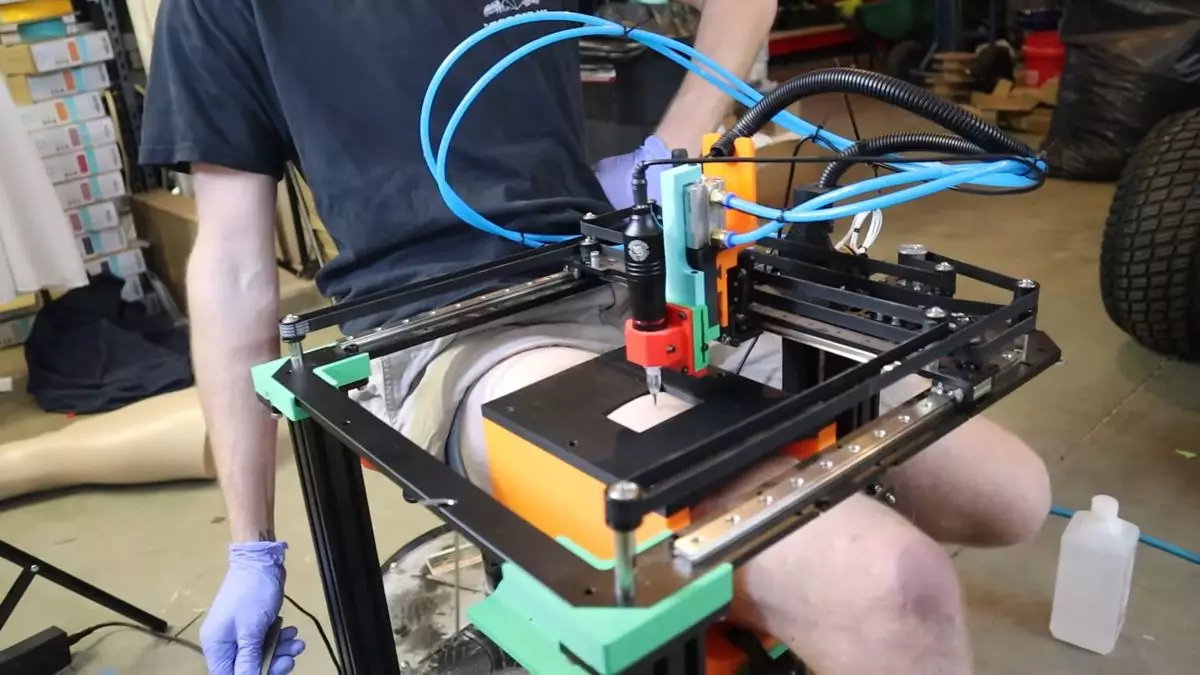The intersection of technology and creativity has always sparked uncharted territory, and few ventures epitomize this spirit quite like the intriguing conversion of a 3D printer into a tattoo machine. YouTube creator Emily The Engineer has taken it upon herself to explore this unconventional approach, pushing the boundaries of what can be achieved with everyday tech. Unlike traditional methods of tattoo application that rely on human artistry and skill, Emily’s project ventures into the realm of automation, aiming for efficiency and perhaps a touch of curiosity alongside a hint of danger.
Emily, who has dabbled in various 3D printing projects, sought to expand her skill set through a project that many would consider risky—tattooing human skin with a machine. This idea was born out of a desire to find an economical solution for tattooing, one that would minimize the costs typically incurred with professional tattoo artists. Her initial steps involved dismantling an old 3D printer, navigating its firmware, and eventually replacing its standard print head with a tattoo gun. To the uninitiated, the mere thought of a tattoo machine fashioned from plastic and metal components might provoke unease, but Emily further enlivened the project with a promise of safety: a panic lever that could halt proceedings at a moment’s notice.
The first phase of her endeavor was dedicated to reshaping the printer’s capabilities to accommodate tattooing. This meant diverting the printer’s standard functions to overlook specifics like temperature control, which is typically critical in both 3D printing and tattoo application. The overseer of this peculiar fusion wasn’t merely experimenting on a whim; Emily conducted preliminary trials with sketches on paper and even tested the machine on her own skin—a commendable move, albeit a risky one.
A notable challenge emerged as the project progressed: the human anatomy is not flat. Despite the considerable modifications done to the printer, the existing structure posed limitations when it came to tattooing specific body parts like legs or arms. Rather than redesigning the entire apparatus from scratch, Emily ingeniously devised a bracket that would flatten the surface of her volunteer’s thigh, making it conducive for the tattooing process. This improvisation perfectly illustrates the experimental spirit driving the project—a blend of ingenuity and practicality that resonates with those who appreciate creative engineering.
Moreover, Emily’s acknowledgment of the potential pitfalls associated with working on human skin—the unknowns of response to the tattooing process—was prudent. A solenoid mechanism was incorporated to elevate the tattoo gun should something go awry, ensuring that safety protocols were in place. This forethought shows a responsible approach to innovation, whereby the thrill of the experiment did not overshadow the importance of user safety.
When the moment finally arrived for Emily’s volunteer, Dan, to be tattooed, a mix of exhilaration and apprehension filled the atmosphere. Attached to the modified printer, Dan lay ready as the machine activated, and the tattoo needle began its work. Surprisingly, instead of the terror one might expect from such an endeavor, Dan later reported the sensation as tolerable. The result? A unique but somewhat rough piece of body art now adorns his thigh—a tangible testament to this bizarre yet fascinating experiment.
However, it’s important to critique both the outcome and the broader implications of this project. While Emily’s endeavor may inspire admiration for its ingenuity, it also raises several ethical concerns regarding the safety and quality of machine-generated tattoos. Tattoos carry significant cultural and personal weight; their creation shouldn’t be relegated to a process that can be so broadly experimental. Furthermore, the risk that comes with less controlled tattooing environments could lead to negative repercussions if such technology is adopted without the proper safeguards and knowledge.
Emily The Engineer’s transformation of a 3D printer into a tattoo machine undoubtedly represents a bold leap into the future of personal art. Whether or not this method is practical for regular use remains debatable, but the project presents fascinating questions about automation, safety, and artistic integrity. While we’re enchanted by our capabilities to innovate, we must balance these pursuits with the responsibility that comes from handling human artistry and technology. For Dan, this experiment may provide more than just a tattoo—it’s a lifelong reminder of the lengths one will go for curiosity and creativity.

